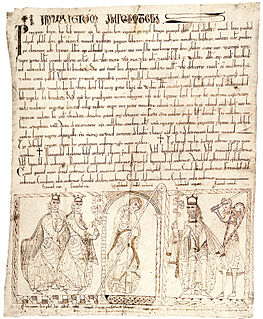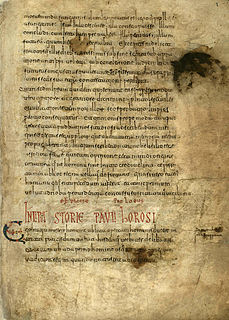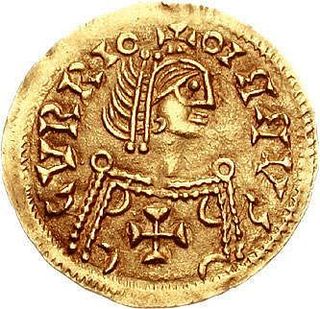
The Visigoths were an early Germanic people who, along with the Ostrogoths, constituted the two major political entities of the Goths within the Roman Empire in Late Antiquity, or what is known as the Migration Period. The Visigoths emerged from earlier Gothic groups, including a large group of Thervingi, who had moved into the Roman Empire beginning in 376 and had played a major role in defeating the Romans at the Battle of Adrianople in 378. Relations between the Romans and the Visigoths were variable, alternately warring with one another and making treaties when convenient. Under their first leader, Alaric I, they invaded Italy and sacked Rome in August 410. Afterwards, they began settling down, first in southern Gaul and eventually in Hispania, where they founded the Visigothic Kingdom and maintained a presence from the 5th to the 8th centuries AD.

The Battle of Roncevaux Pass in 778 saw a large force of Basques ambush a part of Charlemagne's army in Roncevaux Pass, a high mountain pass in the Pyrenees on the present border between France and Spain, after his invasion of the Iberian Peninsula.

The Vascones were a pre-Roman tribe who, on the arrival of the Romans in the 1st century, inhabited a territory that spanned between the upper course of the Ebro river and the southern basin of the western Pyrenees, a region that coincides with present-day Navarre, western Aragon and northeastern La Rioja, in the Iberian Peninsula. The Vascones are often considered ancestors of the present-day Basques to whom they left their name.

Abdullah ibn Muhammad was the seventh Emir of Córdoba, reigning from 888 to 912 in Al-Andalus.
Galindo Aznárez II was Count of Aragon, the son of Aznar Galíndez II and his wife Onneca Garcés, daughter of King García Íñiguez of Pamplona.
Íñigo Arista was a Basque leader, considered the first king of Pamplona. He is thought to have risen to prominence after the defeat of local Frankish partisans at the Battle of Pancorbo in 816, and his rule is usually dated from shortly after the defeat of a Carolingian army in 824.
Jimeno (Ximeno) I was the 9th century father of García Jiménez of Pamplona. In spite of various biographical details having been created, there are no unambiguous records of his existence except in the patronymics of his sons, García and Íñigo Jiménez, indicating a father named Jimeno. In 850, the French court received envoys from Induo and Mitio, "dukes of the Navarrese", and it has been supposed that these names represent those of Íñigo Arista and Jimeno, but Sánchez Albornoz argued against the latter identification. Likewise it has been suggested that, like his son, he may have been ruler of "another part of the kingdom" of Pamplona, or even that he was regent of the entire kingdom. The location of his hypothetical principality has been placed around Álava, where a count Vela Jiménez, traditionally thought to have been his son, held sway.
García Jiménez was king of a part of Pamplona in the late 9th century.

García Íñiguez I, also known as García I was the second king of Pamplona from 851–2 until his death. He was the son of Íñigo Arista, the first king of Pamplona. Educated in Cordoba, he was a successful military leader who led the military campaigns of the kingdom during the last years of his father's life.
Sancho Garcés I, also known as Sancho I, was king of Pamplona from 905 until 925. He was the son of García Jiménez and was the first king of Pamplona of the Jiménez dynasty. Sancho I was the feudal ruler of the Onsella valley, and expanded his power to all the neighboring territories. He was chosen to replace Fortún Garcés by the Pamplonese nobility in 905.
Jimeno Garcés, sometimes Jimeno II, was the King of Pamplona from 925 until his death. He was the brother of King Sancho I Garcés and son of García Jiménez by his second wife, Dadildis of Pallars. When his brother died, Sancho's only son, García Sánchez, was still a child and Jimeno succeeded his brother, becoming the second ruler of the Jiménez dynasty.

Imperator totius Hispaniae is a Latin title meaning "Emperor of All Spain". In Spain in the Middle Ages, the title "emperor" was used under a variety of circumstances from the ninth century onwards, but its usage peaked, as a formal and practical title, between 1086 and 1157. It was primarily used by the kings of León and Castile, but it also found currency in the Kingdom of Navarre and was employed by the counts of Castile and at least one duke of Galicia. It signalled at various points the king's equality with the rulers of the Byzantine Empire and Holy Roman Empire, his rule by conquest or military superiority, his rule over several ethnic or religious groups, and his claim to suzerainty over the other kings of the peninsula, both Christian and Muslim. The use of the imperial title received scant recognition outside of Spain and it had become largely forgotten by the thirteenth century.

The Códice de Roda or Códice de Meyá is a medieval manuscript that represents a unique source for details of the 9th and early 10th century Kingdom of Navarre and neighbouring principalities. It is currently held in Madrid as Real Academia de la Historia cód. 78.

The Visigothic Kingdom or the Kingdom of the Visigoths was a kingdom that occupied what is now southwestern France and the Iberian Peninsula from the 5th to the 8th centuries. One of the Germanic successor states to the Western Roman Empire, it was originally created by the settlement of the Visigoths under King Wallia in the province of Gallia Aquitania in southwest Gaul by the Roman government and then extended by conquest over all of Hispania. The Kingdom maintained independence from the Eastern Roman or Byzantine Empire, whose attempts to re-establish Roman authority in Hispania were only partially successful and short-lived.
Raymond I was the first independent Count of Pallars and Ribagorza from 872 until his death. Early speculation made him a scion of the Counts of Toulouse, but he is certainly the "Count Raymond, son of Count Lupus ... in the country of Pallars" of a 920 document. His father may have been the Basque count Lupus I of Bigorre. During his lifetime Pallars represented the easternmost extent of the Basque language.
Fortún Galíndez was a powerful nobleman in the Kingdom of Navarre in the tenth century. He is the only recorded Navarrese of that time to bear the title dux (duke). He was entrusted by Sancho I with the newly conquered territory of the Rioja Alta around Nájera. In 924 he held the title senior in Naiera ; from 942 he was praefectus in Naiera ; and from 950 he was titled dux. He appears to have governed the Rioja with quasi-regal authority, part of a Navarrese experiment in creating a new kingdom, which would be the Kingdom of Viguera.
Wiliesind was a bishop of Pamplona. His episcopate falls in a very obscure period in Pamplonan history. His predecessor, Opilano, is the first bishop mentioned in source after 693, and no successor of his is known before Jimeno in the 880s. Wiliesind's name is Gothic in origin, although the diocese of Pamplona was predominantly Basque at the time. It probably indicates that Pamplona still looked at Toledo as its spiritual guide, rather than across the Pyrenees.
Munio Vélaz or Vigílaz was the Count of Álava and probably also of Biscay. The exact dates of his countship are unknown. Only one document, dated 18 May 919 in the cartularies of Valpuesta, names Munio as count in Álava. He ruled between counts Gonzalo Téllez and Fernando Díaz. The counts of Álava are described variously in contemporary documents as ruling "in" Álava, Lantarón or Cerezo. The next count after Munio described as ruling Álava proper is Álvaro Herraméliz in 929. They governed the eastern borderlands of the kingdom of León on behalf of the crown.
García Ramírez was an Aragonese prelate and infante. He served as the bishop of Jaca, then the only diocese in Aragon, from 1076 until his death. He temporarily served as the bishop of Pamplona, the principal diocese of neighbouring Navarre, from 1078 until 1082. He was a younger son of King Ramiro I of Aragon and Queen Ermesinda and thus a brother of King Sancho Ramírez. He had good relations with King Alfonso VI of León and Pope Gregory VII, both of whom took his side when he was involved in a dispute with his brother.
Guntislo Galíndez, also spelled Guntisclo, Gutísculo, Gutisclo or Gutislo, was an illegitimate son of Galindo Aznárez II, the last independent count of Aragon. The name of his mother, one of Galindo's servants, is not known. Galindo died without surviving legitimate sons, and his counties were divided between his legitimate daughters: Sobrarbe went to Toda Galíndez and her husband, Count Bernard I of Ribagorza, while Aragon passed to Andregoto Galíndez and her husband, King García Sánchez I of Pamplona. The name Guntislo is of Gothic origin, and is in keeping with the naming practices of the Galíndez counts of Aragon, who favoured names of Gothic and Basque origin.